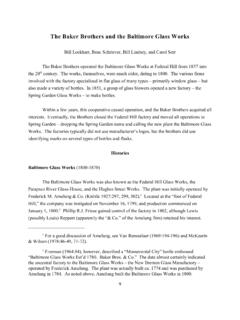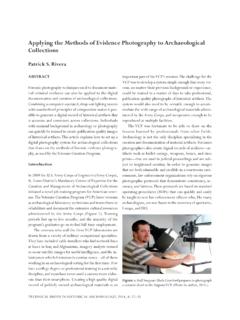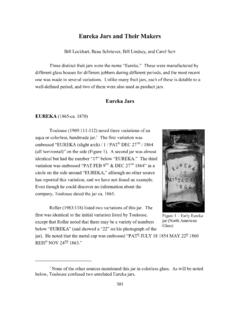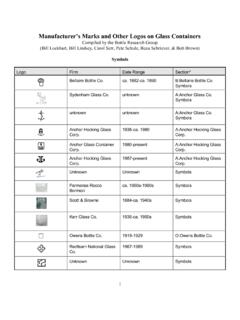Transcription of HEINZ BOTTLE CODES
1 HEINZ BOTTLE CODES . (sent to me 1/18/06, from Consumer Affairs Rep., Andi Cartwright: Use Control+ F to search for a particular BOTTLE number or variety (product). Other base symbols: ( O inside a square) Owens BOTTLE Co. (1911-1929). ( 211 inside a circle) Hazel Atlas Co. (1902-1964). #213 over a<> HEINZ Glasshouse (1900-1943). #255 Owen-Illinois Mr. HEINZ founded the company in 1869. In 1875 he sold his company to his brother John and cousin Frederick. They called their company F&J HEINZ , using the initials from their first names. The eventually sold the companies back to HJ in 1888 and the name became HEINZ . Base plate numbers: #3-mustard jar; produced in HEINZ Sharpsburg glass factory, between 1880-88.)
2 #5-1881-1893; hand blown, 14-paneled tapered sauce decanter BOTTLE woozy sauce and celery #7 was made in the HEINZ Glass Factory in Sharpsburg, PA, a suburb of Pittsburgh. It held 8. ounces of HEINZ Ketchup and was called "the handsome BOTTLE ". It was made between 1880 and 1905. #10, held horseradish, and the BOTTLE was made in the HEINZ Glass Factory located in Sharpsburg, PA, a suburb of Pittsburgh. It was produced from 1895 to 1910. #11 pint of either malt vinegar or dill flavored vinegar. Machine made by Owens-Illinois glass co. between 1922 and 1943. #12-1889-1893. Held dry horseradish, pickled onion and assorted sweet pickle varieties. Cork. Sealed with wax-dip, covered with lead foil.
3 Hand blown flint glass. #13 horseradish, pickle or pickled onions. Made from 1888 to 1896. Hand blown in HEINZ glass factory in Sharpsburg PA. Cork top with foil wrapper. #13 was in use between 1888 to 1895. It was designed for use with all kinds of pickles, horseradish and condiments. It was hand-blown, cork sealed, wax dipped and an embossed lead foil dust cap was placed over the entire finish to keep out all the impurities. These bottles were produced in clear and aqua glass. #14-1870-1900; mustard/ketchup clear quartz glass #15- contained 1/2 pint Princess Olive oil. Machine made 1918-1944. Cork seal crowned with metal cap. Glass stopper was attached to the BOTTLE by a string, which was used as a secondary device after the initial cork was removed.
4 #16 was handmade in the HEINZ Glass factory in Sharpsburg, PA. It was produced from 1883-1903, and held both horseradish (1883-1889) and pickles (1889-1903). #20, held HEINZ Dill Pickles back in 1910. From 1918-1939 it was used to hold mince meat or apple butter. It was machine made and had three labels front, back and a necktie. These labels were hand-applied at the HEINZ plant in Pittsburgh, PA. #21-1890-dry horseradish; cork sealed wax dipped. #22-1919-1921; 10 oz salad dressing #23-1880-1900 pickle products #25-1880-mid 1900 held sweet sour pickle, cauliflower and mustard pickles. Cork sealed wax dipped. Clear quartz glass. #26, Held pickled cauliflower. It was made in the HEINZ Glass Factory located in Sharpsburg, PA, a suburb of Pittsburgh, and produced from 1880 to 1900.
5 #28-woozy sauce 1903-1909 was called Clifford's Worcestershire sauce, named after the founder's son. #28-1903-1909. Clear flint and aqua glass held woozy sauce named after the founder's son Clifford. (Clifford's' Worcestershire sauce). Sealed with glass stopper with perforated cork ring gasket. #30-1880-1898. English style BOTTLE held celery sauce, sweet gherkins, green olives sweet mixed pickles, select pearl onions and imported cauliflower. Hand made in Sharpsburg plant. #33-1885-1900 hand made in Sharpsburg, PA plant. Held Keystone Pearls (small white onions). chutney relish and keystone gems (pickles). #34 The HEINZ Archivist has informed me that he has no record of the BOTTLE in our archives.
6 Unfortunately, he cannot tell you what your BOTTLE was used for. However, he did say that if you could photograph or make a drawing of this BOTTLE for us, he could then try to match the shape of it with the many HEINZ bottles he has in old HEINZ catalogs. #35-1875-1888-This BOTTLE was used to hold pickles. #36-circa 1879-ketchup cork sealed wax-dipped #37 HEINZ glass factory Sharpsburg, PA 1887-1900. Held pickles, pickled onions, Chowchow pickles, mustard pickle, spiced pickle and sweet pickles. #41-1893-1906; HEINZ pepper sauce. Cork sealed. Hand blown up until 1903 then machine made. #42-machine made from late 1920's to mid 1930's. Held sweet and sour pickles and a variety of relishes.
7 Closure was referred to as an Alcoa gold seal cap. #43-1902-1912-olives #47-1896-1903. Held oz. of dehydrated horseradish. Sealed by cork then sealed with wax. And blown in Sharpsburg factory. #49-used for several varieties of tomato and pickle chutney. (No dates listed in letter book; may want to check with Ed for more info). #52 this BOTTLE was produced by the HEINZ Company glass factory located in Sharpsburg, PA, a suburb of Pittsburgh. The BOTTLE held HEINZ Ketchup and was made from 1890 to 1895. The BOTTLE had a cork embedded in the top opening to keep the ketchup clean from any foreign elements. The number 52 was the 52nd BOTTLE design. It had no reference to any varieties.
8 #54 held "select onions". These were very small white onions used in salads. It held 16 oz.'s of product, and was made in the HEINZ Glass Factory in Sharpsburg, PA-a suburb of Pittsburgh. It was only produced for one year, in 1910. #55 was hand-blown in the HEINZ Glass Factory in Sharpsburg, Pa. between 1897 and 1903. It was used to hold 6 ounces of tomato chutney, pearl onions, gherkins, or mustard. (CHECK ON THIS; CAN'T BE BOTH). #55 held various HEINZ products such as pickles, celery sauce and small onions. It was made in the HEINZ Glass Factory in Sharpsburg PA, a suburb of Pittsburgh. It was in use by the company from 1895 to 1903. The BOTTLE shape was referred to as the HEINZ Keystone style.
9 #56 this BOTTLE was produced by the HEINZ Company glass factory located in Sharpsburg, PA. Sharpsburg, a suburb of Pittsburgh. The BOTTLE held HEINZ Ketchup and was made from 1890 to 1895. The BOTTLE Had a cork embedded in the top opening to keep the ketchup clean from any Foreign elements. It also had one of the first Keystone shaped die-cut labels. The number 56 was the 56th BOTTLE design. It had no reference to any Varieties. #57 on the bottom tells us that this BOTTLE held 14 oz. of HEINZ ketchup and was made by hand in the HEINZ Glass factory in Sharpsburg, PA. It was in use from 1895 to 1910, even though the patent was issued in 1890. #58 held oz of ketchup and was used between 1893 and 1896.
10 It was hand blown, cork sealed wax dipped then covered with foil dust cap. It was used as a salesman's sample BOTTLE . #59 from 1892 - 1903. Held several varieties pickles such as Chowchow, sweet, sweet mixed and gherkins. Cork & foil sealed. #63 According to our Archivist, this BOTTLE was in use from 1890 to 1913 and held either mustard dressing or ketchup. From 1890-1900 this BOTTLE was cork-sealed. After that there was an edge added to the rim to hold a metal cap closure. The early version of this BOTTLE , if in excellent condition, is worth approximately $ Later versions would be worth $ to $ #65 held HEINZ Ketchup. Cork sealed. Covered with a lead foil dust cap. (No dates were provided in letter in book-you may want to double check with Ed Lehew for more information).









